More Adventures in Cheese Making

I tried my hand at cheese making again over the Thanksgiving holiday. On Thanksgiving morning, I tried a second mozzarella. This time, I did a better job at the initial filtration of the whey from the curds. I also kneaded it a bit more than last time. The result was an improvement over my first mozzarella. I served it to our Thanksgiving guests as part of a cheese tray for an appetizer.
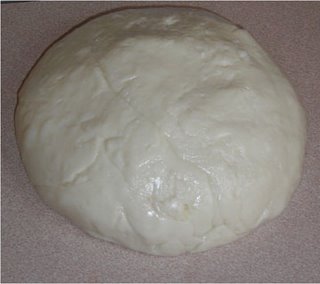
My second mozzarella
I recently got a hard cheese kit as a birthday gift from my sister. I decided to give it a try on Saturday, and made a Gouda. This gave me the opportunity to learn some new techniques: adding a bacterial culture, using a mold, and pressing my cheese.
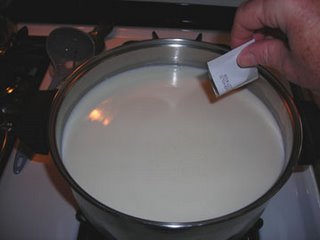
In goes the dried bacterial culture
Unlike mozzarella, you don’t start by acidifying the milk. You just heat it up to 90°F and add a small packet of bacterial culture. I was a bit surprised that you only let the bacteria act on the milk for about 10 minutes before adding the rennet. Adding the rennet involves the usual dissolving part of a tablet in water, then pouring that into the milk.

Adding the rennet
The milk is "top stirred" after the rennet is added. This involved placing the bowl of a ladle into the surface of the milk and stirring gently to prevent early separation at the surface. The whole thing then sits for a full hour (much longer than mozzarella) while the curd forms.

Top stirring
I was pleased that I got a good "clean break" on my first attempt at Gouda. By angling the thermometer into the curd and gently lifting, a clean break was reveled in the surface of the curd. Clear whey rushed into it- exactly they desired effect. The curd was then cut into cubes with a knife, and allowed to settle. Here is where I made my main mistake in the process. The recipe says to let the curds sink for about five minutes and pour part of the whey off (more about that in a moment). Had I waited longer than the recipe called for, I would have had a much easier time with this task.
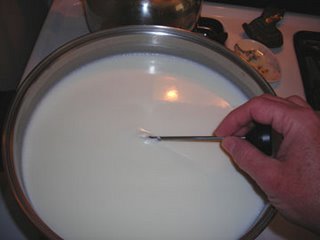
A good "clean break." This means that the curds and whey have separated properly and I will be able to work with the curds as I continue making the cheese.
Gouda is what is referred to as a "washed curd" cheese. This process removes some of the lactose from the curds. After the curds settle, you pour off about a third of the whey. You have some water heated to 175°F sitting near by. Slowly and with plenty of stirring you add the water until the temperature of the curds comes to 92°. The curds then sit for 10 minutes, getting stirred every couple of minutes. By this point, the curds were sinking much more readily into the whey, and it was easy to pour off the whey down to the level of the curds. The washing step was repeated, this time bringing the curd temperature up to 100°. The curds were stirred periodically for 15 minutes and then the whole affair was placed in a sink filled with 100° water for half an hour.
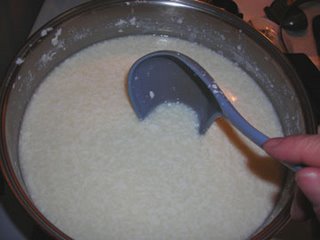
Adding hot water to wash the curds
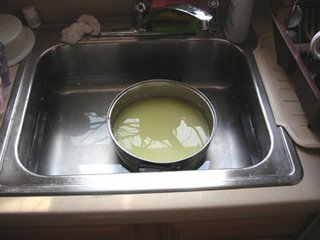
Letting the curds settle afater the second washing
The cheese mold is a plastic basket that gets lined with cheesecloth. After a final decanting of the diluted whey, the curds are quickly ladled into the cheesecloth. The cloth is folded up and over the top of the curds and 20 pounds of weight is added (the 2 bricks I used actually totaled 18 lb. 13 oz.). The cheese is pressed for 20 minutes, flipped and pressed for 12 hours, flipped again, and pressed for another 12 hours. Its then removed from the mold, unwrapped, and placed back in the mold unwrapped and un-weighted for another 8 hours. Finally, the cheese is plunged into brine for 3 hours. The cheese will now have to dry for 3 weeks. I will then have the option of eating it or waxing it and aging for several months.
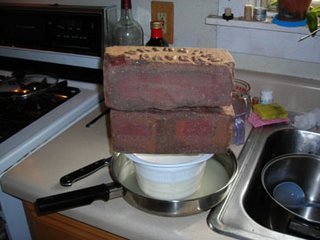
Pressing the curds
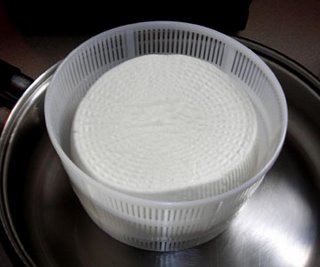
The cheese is flipped and ready for a second round of pressing

The cheesecloth is off, and the Gouda is ready for three weeks of drying in the cellar.
What I learned:
First, hard cheeses are more time consuming than soft ones. That’s OK, at least assuming that the final product is decent. The process wasn’t terribly difficult, though there are a few steps that I’m sure I’ll get better at with practice and experience (cutting the curds, decanting the whey off of the curds). A good thermometer is essential. I think that I want a cheese press. They are not that expensive and have got to be a heck of a lot easier than messing with the bricks. I’d also like to purchase some annatto-based cheese coloring. The Gouda is very white, and that just looks wrong to me. I want to do more of this. My Christmas gift wish list is going to be very easy to put together this year.
Labels: Cheesemaking


12 Comments:
your talents and interest never cease to amaze me.
The gouda sounds delightful.
Can I put in a request for edam, my favorite?
One hobby I never thought of attempting...it looks like you did very good!
I still have to try the mozarella but this looks like fun too. Of course I'll wait until you've mastered this so I'll have someone to query when things go wrong.
Wow...you've got patience. Very cool hobby - I LOVE cheese.
The edam sounds like it would be yummy. It's one of my favorites, too. I have requested a cheesemaking book with lots of recipes in it for Christmas. With luck, that will have an edam recipe in it. My hard cheese kit has a makings and ingredients for parmesan in it. But it has to age for 10 months, so I want to get some results back on other hard cheeses before making that kind of time commitment.
Where can you buy rennet in Chicago? Ive tried Whole foods and Fox and Obel
Greetings and welcome to the Tapestry. I buy all of my specialized cheese making supplies, like rennet, by mail order. I use New England Cheesemaking Supply (http://www.cheesemaking.com/). Drop me an email (dtaron@gmail.com) if you have any other questions.
Re: rennet...I have yet to order from them, but there's a place in Wisconsin for (might be cheaper on shipping if you live in the Midwest)
http://www.thecheesemaker.com
rsb75- Hey, thanks for stopping by the Tapestry. I checked out your link. Wow! Issues of expense aside, they have a great catalog. They have several pieces of equipment that NE Cheesemaking doesn't carry, and that look to have great potential to be helpful. Thanks so much for the tip!
NE Cheesemaking just told me they buy their direct-set starter from a company in Chicago. OK kids, let's find out because I'm sure there's a markup.
Lisa in NYC
Hi Lisa,
Welcome to the Tapestry. I'll see if I can find out anything about this. Will let you know if anything turns up.
Hello Doug,
Just happened to come across your blog. I am super interested in making some kind of cheese at home for some holiday gifts and was curious where you find the culture and rennet in chicago? Also want to see what your idea of the easiest cheese is to make as it is my first time. Thanks for your help. That gouda looks delicious.
Russ
pnormalfiend@gmail.com
Post a Comment
<< Home